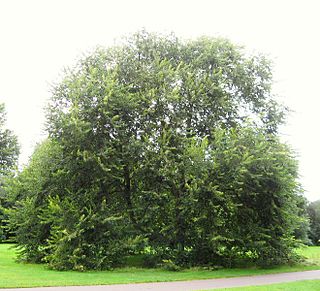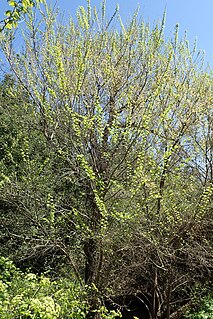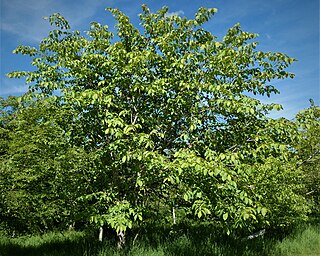
Ulmus wallichianaPlanch., the Himalayan elm, also known as the Kashmir elm and Bhutan elm, is a mountain tree ranging from central Nuristan in Afghanistan, through northern Pakistan and northern India to western Nepal at elevations of 800–3000 m. Although dissimilar in appearance, its common name is occasionally used in error for the cherry bark elm Ulmus villosa, which is also endemic to the Kashmir, but inhabits the valleys, not the mountain slopes. The species is closely related to the wych elm U. glabra.

Ulmus davidiana var. japonica, the Japanese elm, is one of the larger and more graceful Asiatic elms, endemic to much of continental northeast Asia and Japan, where it grows in swamp forest on young alluvial soils, although much of this habitat has now been lost to intensive rice cultivation.

Ulmus laciniata(Trautv.) Mayr, known variously as the Manchurian, cut-leaf, or lobed elm, is a deciduous tree native to the humid ravine forests of Japan, Korea, northern China, eastern Siberia and Sakhalin, growing alongside Cerciphyllum japonicum, Aesculus turbinata, and Pterocarya rhoifolia, at elevations of 700–2200 m, though sometimes lower in more northern latitudes, notably in Hokkaido.
Ulmus chumlia is a small deciduous tree endemic to the Himalaya from the Kashmir to central Nepal, and the provinces of Yunnan, Sichuan and Xizang (Tibet) in China. It is found in broadleaf forest on mountain slopes at elevations of 1000–3000 m. Richens noted that the species appeared to be the same as that named by Grudzinskaya as Ulmus androssowii var. virgata, which she considered an intermediate between U. minor and U. pumila.

Ulmus lanceifoliaRoxburgh, ex Wall., occasionally known as the Vietnam elm, is a very large tree endemic to a wide area of southern Asia. Its range extends southeast and eastwards from Darjeeling in the Himalaya, through Bangladesh, southern China, Myanmar, Thailand, Laos, Vietnam and on discontinuously into Indonesia, straddling the Equator in Sumatra and Celebes.

Ulmus villosa, the cherry-bark elm or Marn elm, is one of the more distinctive Asiatic elms, and a species capable of remarkable longevity. It is endemic to the valleys of the Kashmir at altitudes of 1,200–2,500 metres but has become increasingly rare owing to its popularity as cattle fodder. Mature trees are now largely restricted to temples and shrines where they are treated as sacred. Some of these trees are believed to be over 800 years old.
Ulmus × brandisianaMelville & Heybroek is a naturally occurring elm hybrid found across the Kashmir region, arising from the crossing of Ulmus chumlia and the Himalayan elm, Ulmus wallichiana. The hybrid was formally recognized by Melville and Heybroek after the latter's expedition there in 1960.
The hybrid elm cultivar Ulmus × hollandica 'Dauvessei', one of a number of cultivars arising from the crossing of the Wych Elm U. glabra with a variety of Field Elm U. minor, is a very rare cultivar said to have originated at the D. Dauvesse nursery in Orléans, France before 1877.

Ulmus minorsubsp.canescens is a small deciduous tree occasionally known by the common names grey elm, grey-leafed elm, and hoary elm. Its natural range extends through the lands of the central and eastern Mediterranean, from southern Italy, the islands of Sicily, Malta, Crete, Rhodes and Cyprus, to Turkey, and as far south as Israel, where it is now considered rare and endangered in the wild. The tree is typically found amidst the comparatively humid coastal woodlands and scrublands.

Ulmus 'Exoniensis', the Exeter elm, was discovered near Exeter, England, in 1826, and propagated by the Ford & Please nursery in that city. Traditionally believed to be a cultivar of the Wych Elm U. glabra, its fastigiate shape when young, upward-curving tracery, small samarae and leaves, late leaf-flush and late leaf-fall, taken with its south-west England provenance, suggest a link with the Cornish Elm, which shares these characteristics.

The hybrid elm cultivar Ulmus 'Den Haag' is a Dutch development derived from a chance crossing of the Siberian Elm cultivar Ulmus pumila 'Pinnato-ramosa' and the Belgian Elm Ulmus × hollandica 'Belgica'. S. G. A. Doorenbos (1891-1980), Director of Public Parks in The Hague, finding that seeds he had sown in 1936 from the Zuiderpark 'Pinnato-ramosa' had hybridized with the local 'Belgica', selected six for trials. The best was cloned and grafted on 'Belgica' rootstock as 'Den Haag'; it was planted first in that city, then released to nurseries elsewhere in the Netherlands. The other five were also planted in The Hague.
Ulmus laevis var. celtideaRogow. is a putative variety of European White Elm first described by Rogowicz, who found the tree in 1856 along the river Dnjepr near Chernihiv in what is now northern Ukraine. The type specimen is held at the National Herbarium of Ukraine. The variety was first named as Ulmus pedunculata var. celtidea. Litvinov (1908) considered it a species, calling it Ulmus celtideaLitv., a view not upheld by other authorities.
The elm cultivar Ulmus 'Myrtifolia', the Myrtle-leaved Elm, first appeared in nursery and horticultural lists from the 1830s, as Ulmus myrtifolia and Ulmus campestris myrtifolia, the name Ulmus myrtifoliaVolxem being used at Kew Gardens from 1880. Lawson's nursery of Edinburgh appears to have been the earliest to list the tree. 'Myrtifolia' was listed by Nicholson in Kew Hand-List Trees & Shrubs (1896), but without description. It was later listed as a cultivar and described by Rehder in 1939 and by Krüssmann in 1962.

Hans M. Heybroek was a Dutch botanist best known for his research into the genus Ulmus at the Dorschkamp Research Institute for Forestry & Landscape Planning. Until his retirement in 1992, he was responsible for the raising and release of numerous elm hybrid cultivars, notably 'Columella'. Specializing in phytopathology, Heybroek also investigated the Coral Spot fungus Nectria cinnabarina in elm. In 1960 he travelled to the Kashmir to search for a frost-hardy form of the Himalayan Elm Ulmus wallichiana as a source of anti-fungal genes for use in the Dutch elm research programme.

The elm Ulmus wallichiana subsp. xanthoderma was identified by Melville and Heybroek after the latter's expedition to the Himalaya in 1960. The tree is of more western distribution than subsp. wallichiana, ranging from Afghanistan to Kashmir.
Ulmus wallichiana subsp. wallichiana was identified by Melville and Heybroek after the latter's expedition to the Himalaya in 1960.

The Field Elm cultivar Ulmus minor 'Goodyeri', commonly known as 'Goodyer's Elm', was discovered by John Goodyer in 1624 at Pennington near the Hampshire coast between Lymington and Christchurch. No old specimens are known to survive, but the tree is perpetuated by numerous root suckers, notably in the lanes about the Alice Lisle public house in the New Forest hamlet of Rockford. The tree has suffered misidentification in the centuries since its discovery, firstly by Philip Miller in his 'Gardeners' Dictionary' of 1731, and later in the early 20th century by Augustine Henry and Marcus Woodward, who both confused the tree with Plot Elm, whose centre of distribution is in the East Midlands, some 200 miles away and of completely different appearance.
The Field Elm cultivar Ulmus minor 'Viminalis Betulaefolia' (:'birch-leaved') is an elm tree of uncertain origin. An U. betulaefolia was listed by Loddiges of Hackney, London, in the catalogue of 1836, an U. campestris var. betulaefolia by Loudon in Arboretum et Fruticetum Britannicum (1838), and an U. betulifoliaBooth by the Lawson nursery of Edinburgh. Henry described an U. campestris var. betulaefolia at Kew in 1913, obtained from Fulham nurseryman Osborne in 1879, as "scarcely different from var. viminalis ". Melville considered the tree so named at Kew a form of his U. × viminalis, while Bean (1988), describing U. 'Betulaefolia', likewise placed it under U. 'Viminalis' as an apparently allied tree. Loudon and Browne had noted that some forms of 'Viminalis' can be mistaken for a variety of birch. An U. campestris betulaefolia was distributed by Hesse's Nurseries, Weener, Germany, in the 1930s.
The Field Elm cultivar Ulmus minor 'Glandulosa' was described as Ulmus glabra [:smooth-leaved] Mill. var. glandulosa by Lindley in A Synopsis of British Flora, arranged according to the Natural Order (1829), from trees near Ludlow, Shropshire. Melville identified a specimen in Ludlow in 1939, calling it in a 1946 paper "a good form of U. carpinifolia" [:U. minor ], describing it more fully and renaming it U. carpinifoliaGled. var. glandulosa (Lindl.). Regarding it as out of its natural range and deliberately planted, he referred to it as The Ludlow Elm, the "type tree" of a "variety" of Field Elm. Herbarium specimens of 'Glandulosa' are held in both the Lindley Herbarium in Cambridge and the Borrer Herbarium at Kew.










